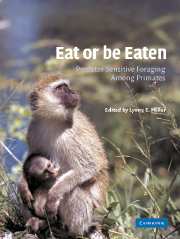Book contents
- Frontmatter
- Contents
- List of contributors
- Preface
- 1 An introduction to predator sensitive foraging
- PART I BIOLOGICAL VARIABLES
- PART II SOCIAL VARIABLES
- 6 The role of group size in predator sensitive foraging decisions for wedge-capped capuchin monkeys (Cebus olivaceus)
- 7 Group size effects on predation sensitive foraging in wild ring-tailed lemurs (Lemur catta)
- 8 Species differences in feeding in Milne Edward's sifakas (Propithecus diadema edwardsi), rufus lemurs (Eulemur fulvus rufus), and red-bellied lemurs (Eulemur rubiventer) in southern Madagascar: Implications for predator avoidance
- 9 Evidence of predator sensitive foraging and traveling in single- and mixed-species tamarin troops
- 10 Predator (in)sensitive foraging in sympatric female vervets (Cercopithecus aethiops) and patas monkeys (Erythrocebus patas): A test of ecological models of group dispersion
- 11 Predation risk and antipredator adaptations in whitefaced sakis, Pithecia pithecia
- PART III ENVIRONMENTAL VARIABLES
- Index
9 - Evidence of predator sensitive foraging and traveling in single- and mixed-species tamarin troops
Published online by Cambridge University Press: 10 November 2009
- Frontmatter
- Contents
- List of contributors
- Preface
- 1 An introduction to predator sensitive foraging
- PART I BIOLOGICAL VARIABLES
- PART II SOCIAL VARIABLES
- 6 The role of group size in predator sensitive foraging decisions for wedge-capped capuchin monkeys (Cebus olivaceus)
- 7 Group size effects on predation sensitive foraging in wild ring-tailed lemurs (Lemur catta)
- 8 Species differences in feeding in Milne Edward's sifakas (Propithecus diadema edwardsi), rufus lemurs (Eulemur fulvus rufus), and red-bellied lemurs (Eulemur rubiventer) in southern Madagascar: Implications for predator avoidance
- 9 Evidence of predator sensitive foraging and traveling in single- and mixed-species tamarin troops
- 10 Predator (in)sensitive foraging in sympatric female vervets (Cercopithecus aethiops) and patas monkeys (Erythrocebus patas): A test of ecological models of group dispersion
- 11 Predation risk and antipredator adaptations in whitefaced sakis, Pithecia pithecia
- PART III ENVIRONMENTAL VARIABLES
- Index
Summary
Introduction
The threat of predation and behavioral tactics associated with predator avoidance are reported to play a critical role in primate socioecology (Hill and Dunbar 1998, Terborgh and Janson 1986, van Schaik 1983). In particular, it has been suggested that predation risk can have a significant effect on group size and composition (Cheney and Wrangham 1987, Isbell 1994, Stanford 1998, Treves 1999), vigilance behavior (Burger and Cochfeld 1994), patterns of habitat utilization (Cowlishaw 1999), within-group spacing, and individual foraging success (Cowlishaw 1998). Hill and Dunbar (1998: 412) define predation risk as ‘the animals’ own perception of the likelihood of being subject to an attack by a predator … it reflects the animals' collective past historical experience of actual attacks by predators and is the basis on which the animals implement their antipredator strategies.' In social animals, individuals may assess predation risk based on their own personal information, as well as by relying on alarm calls and vigilance behavior provided by other group members. Several authors have suggested that when relying on group-based information, including shared vigilance, individuals living in larger social groups experience lower predation risk than conspecifics living in smaller social groups (Janson and Goldsmith 1995, Terborgh 1990, Terborgh and Janson 1986, van Schaik 1983). The mechanisms promoting shared or cooperative vigilance, however, are poorly understood (Lima and Bednekoff 1999).
Tamarin monkeys.
In this chapter, we examine evidence of predator sensitive foraging in wild tamarins in an attempt to link social interactions, foraging patterns, and predator avoidance behaviors. Specifically, we examine evidence of antipredator behavior in single and mixed-species troops of saddleback (Saguinus fuscicollis weddelli) and emperor (S. imperator imperator) tamarins when foraging at experimental feeding platforms.
- Type
- Chapter
- Information
- Eat or be EatenPredator Sensitive Foraging Among Primates, pp. 138 - 153Publisher: Cambridge University PressPrint publication year: 2002
- 19
- Cited by



